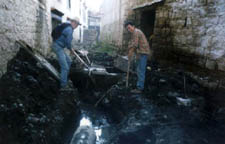In 1999, THF welcomed a new water engineer, Mr. John Niewoehner. Altogether 1256 old city residents benefitted from upgraded toilets, drain and sewer connections and improved water supply. Two new toilets were built, 25 toilets upgraded and connected to sewer, 23 buildings had their water supply and 15 their drainage improved.
In detail: Dzomora: a drain was built for the courtyard water tapstand, $29. Gamposhar: new tapstand and new drain, $159. Ganden Khangsar: THF conducted a survey of the collapsed toilet system for the 300 inhabitants of Ganden Khangsar, and the Technical University FH Luebeck is developing an ecological toilet model with the aim to revive the old composting system. Costs so far: $512. Gangkashar: this building located on the way to Merunyingba monastery had no toilet at all for its 4 resident families. One site of the courtyard was occupied by majestic corner walls of the old Zongra House, which was demolished in 1993 but this particular corner was left standing to support the weaker Gangkashar leaning against it. THF found enough empty space between the walls and the new building that repaced Zongra to fit in a sewer-connected toilet, using the old corner as entrance. A water connection for flushing has also been provided. Total costs: $3,677.
Gorashar: sewer connection: $451. Jamyang complex / Tara and central courtyards: new drainage system and paving of the courtyards, $3,856. Jokhang Temple: the monks' toilets were fitted with water and connected to sewers, and the bathrooms were further fitted with handwash basins, $270. Juenpa: work here has just begun on building a new drainage system and repairing the tapstand (not completed), $91. Kagyeshar: provisorial connection of toilet to sewer (no toilet upgrading yet) $18. Karma Kussang Sera Shika: the traditional Tibetan toilets empty in a vault, which has to be emptied manually quite regularly. More and more families occupying sub-divided flats in what has once been the home of a single rich family, and the disintegration of the old composting system (less farming land in the Lhasa valley plus government-promoted usage of chemical fertilizer) have strained the traditional toilet system literally to the bursting point. The seepage of vaults not emptied for some time causes considerable damage to the walls of a house, until the entire toilet area can collapse. This happened in one of the few surviving historic buildings in the Karma Kussang (originally Karma Gonsar) areas of Lhasa. The Sera Shika house is inhabited by a lone old nun who was unable to maintain the traditional toilet. One night, the collapsing toilet brought part of the house down. The toilet area was rebuilt, with permission from the Karma Kussang Neighbourhood Office, at a cost of $573,-. Kharden: A similar collapse occured in the protected Khaden House, a 19th century noble residence.The collapse unfortunately brought down a large section of the ouside wall, and if unchecked more damage was likely to happen. The toilet area was rebuilt at a cost of $1,228. Labrang Nyingba: upgrading the eastern wing's toilet system (western wing was upgraded in 1998): $374. Merunyingba: the German-Embassy-funded restoration was complimented by the upgrading of two toilet systems for the lay residents, and building of one system for the monks, as well as providing the monks with a solar-heated shower facility. Total costs: $3,034. Minkyling: complimenting the Cultural-Relics-funded restoration of Mindrochang, THF upgraded the toilet of neighbouring Minkyling on request, $792,-. Nagtsagjang: unblocking of drain. Nangmamo: this large building inhabited by 22 families has been part of community activities since 1997. Emergency repairs in the toilet system were financed at $51. Numa: in cooperation with the private owner, the collapsed toilet system was rebuilt for 276,-. Oedepug: Oedepug alley was partially repaved to improve rainwater drainage and to correct the street level in relation to some of the entrace gates, $405. Rongda: the Dutch-Embassy-funded restoration of Rongda House was complimented by further toilet and drainage improvement, $603. Shekarlingpa: a collecting vault toilet without sewer connection in this 1990-built courtyard was improved by first emptying the vault which seemed to not have happened in several years, plus subsequent upgrading to sewer toilet, $289. Sungchoera: new drains and sewers connecting one of the four new housing blocks in this area, $221,-. School teachers' building / former Kagye-ma: sewer connection, $41. All of the above were provided by the Canada Fund, in total: $19,882. More details are available in the THF 1999 Water and Sanitation Report. Trace Foundation supported the training of the local water and sanitation work team (see chapter 5) and further support came from the Young Presidents' Organization. |

